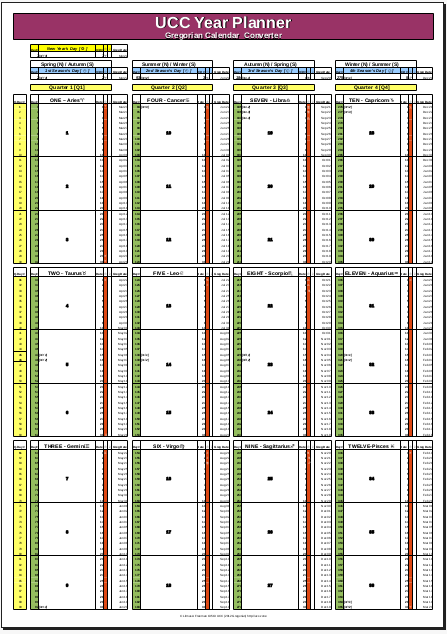Universal Celestial Calendar: Wiki Main Page
The Universal Celestial Calendar (UCC) (previously known as the Universal Community Calendar) is a 12 month, non-sectarian, perennial, solar calendar aimed at helping to foster a deeper awareness of our place and time in relation to natural celestial cycles. It proposes a 'Universal' calendar system for the planet that is independent of any religion and closely tied astronomically to Earth's relationship to the Sun and the Zodiac. It is particularly aimed at new/emerging communities and/or individuals who are seeking natural harmony and who do not need to conform to the Gregorian seven day week system. The UCC has been made a 'Standing Proposal For Calendar Reform' since its launch in 13513 UCC (2012 AD).
Today's UCC Date is:
Contents
[hide]- 1 Summary of Features
- 2 More About Decans
- 3 More About Triads
- 4 Writing UCC Dates
- 5 More About Festivals
- 6 More About The Great Year
- 7 Proposed Aims & Benefits
- 8 UCC Resources
- 9 Coding with UCC Dates
- 10 How To Generate The Symbols Used By The UCC
- 11 See Also
- 12 Further Reading
- 13 External Links
- 14 Notes & References
Summary of Features[edit]
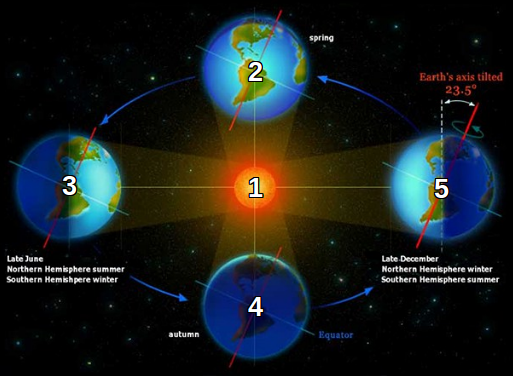
The Standard (Non Leap) Year[edit]
The UCC year follows the annual path of the Sun through the Zodiac relative to Earth's orbit and therefore is divided into several equal sections based on celestial events. These divisions are: 4 Quarters of 90 days, 12 equal months of 30 days which are called 'Triads' and 36 weeks of 10 days which are called 'Decans'. These are explained in more detail below.
Days of the Year[edit]
A standard year of 365 days in the UCC is made up of 360 standard days and 5 intercalary days.
Quarters[edit]
The 360 standard days are divided into 4 equal 90 day Quarters (seasons) each of which is preceded by an intercalary day.
Triads (months) & Decans (weeks)[edit]
Each quarter consists of three of the 30 day Triads, each containing three of the 10 day Decans. The year therefore consists of 12 Triads and 36 Decans, making up the 360 standard days (12 x 30 = 360 and 36 x 10 = 360).
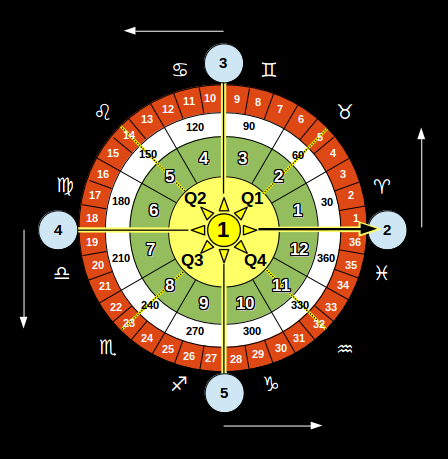
Intercalary Days[edit]
There are 5 intercalary days in a standard year, one called 'New Year's Day' to celebrate the new year at the start of a new orbit and four others called 'New Season's Days' which celebrate each of the equinoxes and solstices and precede each Quarter season. The intercalary days "balance" the calendar year into its 4 equal Quarters.
Eight Seasonal Festivals[edit]
Each quarter also has 2 Festivals, one which celebrates the start of each season at the equinoxes and solstices and therefore includes their associated intercalary days, and another which celebrates the mid point of each season when the Sun is half way between an equinox and solstice. These 8 festivals align closely with those of the 'Eight Fold Year', also known as 'The Wheel of the Year', as celebrated by such ancient groups as the druids.
The Start of the Year[edit]
The standard UCC year begins with the first intercalary day, 'New Year's Day', which is the first full day after the Aries Equinox. This is circa 21st March in the Gregorian calendar. The start of the year is kept in synch with the Aries Equinox by the insertion, before New Year's Day, of an extra intercalary day in Leap Years.
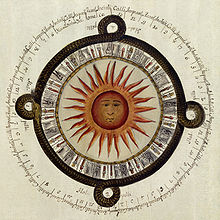
Leap Years[edit]
Leap years follow a system of 8 leap years every 33 years, a close approximation of the Persian Hijri calendar. The fraction 8/33 equates to 0.2424 days, very close to the extra 0.2422 days which the earth actually rotates during its annual orbit around the Sun, thereby keeping calendars using this system extremely accurate over very long periods of time. In the 33 year cycle years 1, 5, 9, 13, 17, 22, 26 & 30 are leap years. (You can view a full table of UCC Leap Years and how they correlate with Gregorian leap years on the UCC website here)
The additional (6th) intercalary day in leap years is called 'Leap Year's Day' and is inserted at the start of the year as 'day zero' thereby keeping the day numbers perennial (the same for every year).
The Year Number[edit]
The UCC follows the Great Year cycle, known to the Hindus as the Yuga cycle and to astronomers as the Precession of the Equinoxes. In line with the work of Sri Yukteswar Giri, the Great Year is suggested by some researchers/authors such as Walter Cruttenden in his book Lost Star, to be a 24,000 year cycle due to the varying rate of precession. The UCC also adopts this premise and so its year number increases from 0 to 24,000 over the Great Year cycle.
According to Sri Yukteswar the Great Year cycle commences at its peak, when the Libra Equinox is at the first point of the constellation Aries[1] which last occurred in 11,501BCE[2] and therefore equates to Year 1 in the UCC.[3] The first full day after the Aries equinox in the year 2000 C.E. therefore equated to the first day of the year 13,501 UCC.
For more detail see 'More About The Great Year' below
More About Decans[edit]
The 360 standard days are divided into 36 'Decans'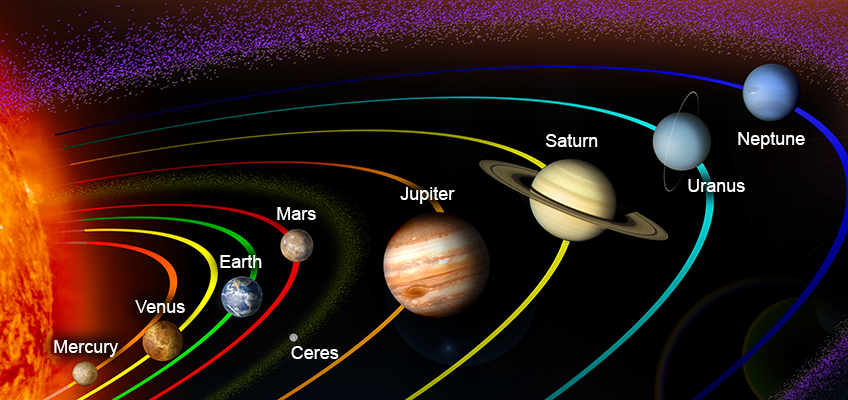
The name 'Decans' is appropriate as this refers historically to 36 groups of stars and a period of 10 days as well as the number 10.
The days of the Decan do not really need names since, in contrast to the Gregorian calendar, they do not move with the date each year, but if desired can be called 'Onesday', Twosday, Threesday etc. Alternatively the days can be called after their associated Orb: Sun Day, Mercury Day, Venus Day and so on, and can be written using their associated symbols as follows:
☉ ☿ ♀ ⴲ ♂ ⚳ ♃ ♄ ♅ ♆
The Days of the Decan[edit]
| 1 | 2 | 3 | 4 | 5 | 6 | 7 | 8 | 9 | 10 |
|---|---|---|---|---|---|---|---|---|---|
| Onesday | Twosday | Threesday | Foursday | Fivesday | Sixday | Sevensday | Eightsday | Ninesday | Tensday |
| Sun | Mercury | Venus | Earth | Mars | Ceres | Jupiter | Saturn | Uranus | Neptune |
| Sun Day | Mercury Day | Venus Day | Earth Day | Mars Day | Ceres Day | Jupiter Day | Saturn Day | Uranus Day | Neptune Day |
| ☉ | ☿ | ♀ | ⴲ | ♂ | ⚳ | ♃ | ♄ | ♅ | ♆ |
There is a precedent for ten day weeks in the ancient Egyptian Calendar (also called 'Decans') and the French Republican Calendar.
No Weeks and Weekends[edit]
Since the UCC uses Decans rather than weeks, there is not the distinction between weekdays and weekends that is found in the Gregorian system. Early adopters of the UCC can be found on several continents and some have been alternative communities,[4][5][6] who have found that this 10 day 'week' structure has allowed them to be less formal about how days are split between work (energy dedicated to the community) and relaxation/personal development. Some of these communities tend to encourage community members to dedicate three days in each Decan to community projects and the remainder are available to the individual for relaxation and self realisation or 'life mission' work.
More About Triads[edit]
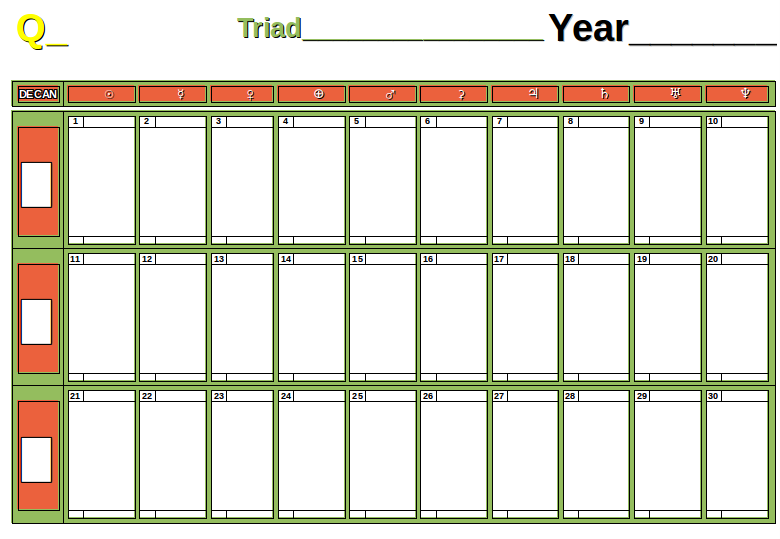
The 12 equal 30 day 'Triads' are the main components of the calendar. They are called Triads (meaning 'group of three') due to their three-fold nature, as there are 3 of them in each quarter and each of them has 3 of the 36 Decans (36 / 12 = 3).[7] All 12 Triads have exactly the same structure and the day numbers always stay the same so that the same 30 day template can be used for all Triads every year.
Triads and Astrology[edit]
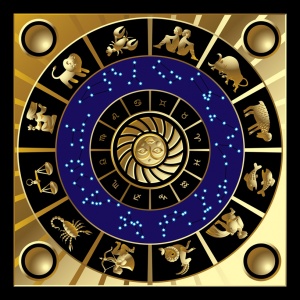
The Triads are named after their number in sequence, ONE, TWO, THREE etc, together with the associated Western Tropical Zodiac Sign that they closely align with and its symbol. So the names are as follows, shown in their respective Quarter seasons:
| Q1 | Q2 | Q3 | Q4 |
|---|---|---|---|
| ONE-Aries♈ | FOUR-Cancer♋ | SEVEN-Libra♎ | TEN-Capricorn♑ |
| TWO-Taurus♉ | FIVE-Leo♌ | EIGHT-Scorpio♏ | ELEVEN-Aquarius♒ |
| THREE-Gemini♊ | SIX-Virgo♍ | NINE-Sagittarius♐ | TWELVE-Pisces♓ |
Again, there is a precedent for 12 months of 30 days in the Egyptian calendar and French Republican calendar and several other calendars use the names in their language of the 12 Zodiac Signs or Constellations as their month names, such as the Babylonian calendar and Hindu Calendar
When writing dates in the UCC the symbol of the Zodiac Sign may be used as shorthand for its associated Triad month: ♈ ♉ ♊ . ♋ ♌ ♍ . ♎ ♏ ♐ . ♑ ♒ ♓
Since the UCC follows the Sun, the UCC Date of the Triad will often coincide, certainly within a degree or two, with the degree of the equivalent Zodiac Sign that the Sun is at during that day. For example at the time of writing it is the 7th of FOUR-Cancer♋ in the UCC (28th of June in the Gregorian calendar) and the Sun is at 7° Cancer♋.
Triads and Astronomy[edit]
Astronomically each Zodiac Sign, and therefore its associated UCC Triad, corresponds very closely to 2 hours of Right Ascension (RA), the astronomical equivalent of longitude which is used together with declination to determine the positions of celestial bodies. Whilst the astrological positions of such bodies and geographic longitude are measured in degrees, minutes and seconds (°, ', ") right ascension is measured in hours, minutes and seconds (h, m, s) which can make things rather confusing for the layman. Fortunately all three share a common starting reference, the prime meridian, and both astrology and astronomy use its intersection with the ecliptic and the celestial equator as their starting point from which to measure the celestial sphere. Since astronomy originally developed from astrology this point is still known in astronomy as 'the first point of Aries' and so the symbol for the Zodiac Sign Aries '♈' is used to denote it. It is measured as 0°Aries♈ in astrology and 0h0m0s RA in astronomy
Right ascension is effectively the 24 hour clock of the celestial sphere where one hour of right ascension equates to 15° of the ecliptic (360°/24=15°) and since there are 12 Zodiac Signs each one is equivalent to 2 hours RA. Since the 12 UCC Triads align very closely with the 12 Zodiac Signs they also then correspond closely to the 2 hour sections of RA as follows:
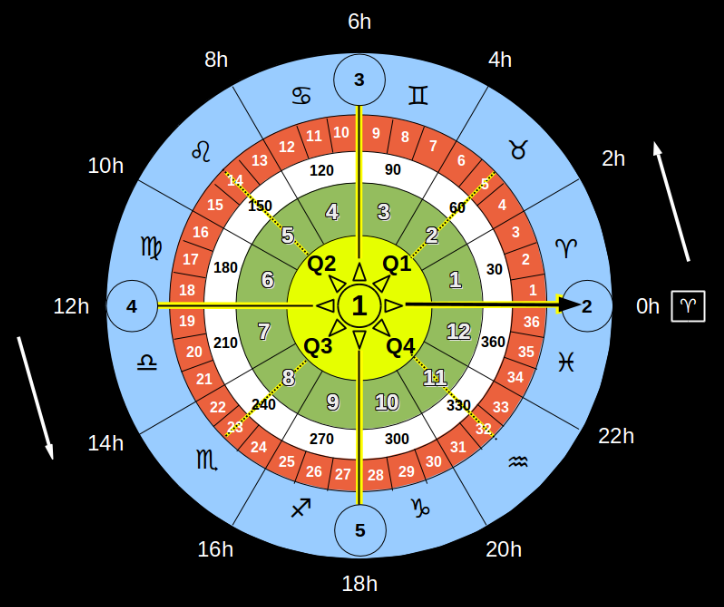
| Zodiac Sign | Starts At (°) | Starts At (RA) | |
|---|---|---|---|
| 1 | Aries♈ | 0° | 0h |
| 2 | Taurus♉ | 30° | 2h |
| 3 | Gemini♊ | 60° | 4h |
| 4 | Cancer♋ | 90° | 6h |
| 5 | Leo♌ | 120° | 8h |
| 6 | Virgo♍ | 150° | 10h |
| 7 | Libra♎ | 180° | 12h |
| 8 | Scorpio♏ | 210° | 14h |
| 9 | Sagittarius♐ | 240° | 16h |
| 10 | Capricorn♑ | 270° | 18h |
| 11 | Aquarius♒ | 300° | 20h |
| 12 | Pisces♓ | 330° | 22h |
This together with a little knowledge of which Zodiac Age we are in the Great Year cycle (see More About The Great Year below) means the UCC can be used to help determine which Zodiac Constellations will be in the night sky at any given time of the year by looking at the current Triad's opposite. For example during the fourth Triad of the UCC Year, FOUR-Cancer♋, the Sun will be rising in the equivalent Zodiac Sign, Cancer♋, and this Sign will be overhead at the Sun's zenith (at solar noon) meaning that it's opposite Sign, Capricorn♑, currently housing the Constellation Sagittarius,[8] will be in that position at solar midnight.
Writing UCC Dates[edit]
UCC dates, like those in any calendar, can be written in several formats.
Dates of Standard Days[edit]
Standard days for example can be written with the full names of their Triad and the full year number, or in abbreviated form with numbers and/or symbols. So the date for the first day of the first Triad for the year 13501 could be written in the following ways:
In Full: 1st ONE-Aries♈ 13501;
Using Numbers: 1/1/13501 or 1/1/01;
For Numerically Sorting: 13501.01.01;
Using Symbols & Numbers: 1♈13501 or 1♈01
Dates of Intercalary Days[edit]

The 5 intercalary days in a standard year are made up of:
One 'New Year's Day' which celebrates the new year at the start of a new orbit;
Four 'New Season's Days' which celebrate each of the equinoxes and solstices and precede each Quarter season.
New Year's Day [❂][edit]
New Year's Day is day number 1 of the year but is not associated with any of the 12 standard Triads and so its Triad number is 0 (zero). Its date is therefore counted as Day 1 of Triad 0. For example for the year 13501 it can be written as follows:
In Full: 1st ZERO 13501
Using Numbers: 1/0/13501 or 1/0/01
For Numerically Sorting: 13501.00.01
The intercalary days have also been given symbols. The symbol for New Year's Day is '❂', an eight pointed star in a circle, to show the eight fold nature of each year with it's quarters and cross quarters. So this symbol can also be used to write the date using numbers & symbols as:
❂13501
New Season's Days[edit]
New Season's Days on the other hand are associated with the Triad immediately following them at the start of each Quarter season because they celebrate the equinoxes and solstices.[9] They are given the day number 0 (zero) of that Triad. Their symbols then show pictorially which Quarter they precede.
1st Season's Day [◷][edit]
This celebrates the Aries Equinox ('Nobenox') and so is day 0 of ONE-Aries♈ and has the symbol ◷
In Full: 0 ONE-Aries♈ 13501
Using Numbers: 0/1/13501 or 0/1/01
For Numerically Sorting: 13501.01.00
Using Symbols & Numbers: ◷13501
2nd Season's Day [◴][edit]
This celebrates the Cancer Solstice ('Nolstice') and so is day 0 of FOUR-Cancer♋ and has the symbol ◴
Full: 0 FOUR-Cancer♋
Numbers: 0/4/13501 or 0/4/01
Numerical: 13501.04.00
Symbols & Numbers: ◴13501
3rd Season's Day [◵][edit]
This celebrates the Libra Equinox ('Sobenox') and so is day 0 of SEVEN-Libra♎ and has the symbol ◵
Full: 0 SEVEN-Libra♎
Numbers: 0/7/13501 or 0/7/01
Numerical: 13501.07.00
Symbols & Numbers: ◵13501
4th Season's Day [◶][edit]
This celebrates the Capricorn Solstice ('Solstice') and so is day 0 of TEN-Capricorn♑ and has the symbol ◶
Full: 0 TEN-Capricorn♑
Numbers: 0/10/13501 or 0/10/01
Numerical: 13501.10.00
Symbols & Numbers: ◶13501
Leap Year's Day [✶][edit]
In Leap Years this 6th intercalary day, which celebrates the leap year's realignment with the Aries Equinox, is inserted as day number 0 (zero) before New Year's Day at the start of the year. Like New Year's Day it is not associated with any of the 12 standard Triads and so its Triad number is also 0 (zero). Its date is therefore counted as Day 0 of Triad 0. Its symbol is '✶', a six pointed star to acknowledge the 6th intercalary day required to realign the start of the year. So again for the year 13501 (which was actually a UCC leap year) it can be written as follows:
Full: 0 ZERO 13501
Numbers: 0/0/13501 or 0/0/01
Numerical: 13501.00.00
Symbols & Numbers: ✶13501
More About Festivals[edit]
The eight seasonal solar festivals are made up of 4 cardinal festivals and 4 mid season festivals.Cardinal Festivals[edit]
The cardinal festivals are associated with the 4 cardinal signs of the Zodiac and their related Triads, that open each Quarter/season at the equinoxes and solstices, which in turn make up the Solar Cross (also known as the Sun Cross). The symbol for the Solar Cross 'ⴲ' is at the heart of the structure of the calendar. These celebrations therefore take place around the start of the 4 opening Triads of each Quarter and include their related intercalary days. The Quarter Days in Britain and Ireland traditionally fell close to these times of the year.
In the traditional 'Eight-Fold Year' of ancient peoples these celebrations are called by various names depending on the culture but often as Ostara (Aries♈ Equinox), Litha (Cancer♋ Solstice), Mabon (Libra♎ Equinox) and Yule (Capricorn♑ Solstice).
In the UCC the balance of the Equinoxes involve 4 Day celebrations whilst the Solstices are 3 Day affairs: The New Year Festival of Aries♈, takes in 29th & 30th of TWELVE-Pisces♓ in the old year and New Year's Day & 1st Season's Day of the new year, except in Leap Years when Leap Year's Day is inserted in the middle making it a 5 Day festival; The Festival of Cancer♋ starts on the 30th of THREE-Gemini♊ and includes 2nd Season's Day & 1st of FOUR-Cancer; The Festival of Libra♎ begins on 3rd Season's Day and ends on 3rd of SEVEN-Libra♎; The Festival of Capricorn♑ includes 4th Season's Day and the 1st & 2nd of TEN-Capricorn♑.
Mid Season Festivals[edit]
The mid season festivals are associated with the 4 fixed signs of the Zodiac and their related Triads, which are in the middle of each Quarter/season. These 2 Day festivals therefore take place on the middle two days, the 15th & 16th, of the middle Triad of each Quarter. This is when the Sun is half way between an equinox and solstice and these 4 points form the 'Galactic Cross' (symbol '⊗'), traditionally associated in Britain with the Cross Quarter Days.
In the Eight-Fold Year these approximate times are celebrated in the northern hemisphere as Beltane in mid spring (Mid Taurus♉), Lughnasadh in mid summer (Mid Leo♌), Samhain in mid autumn (Mid Scorpio♏) and Imbolc in mid winter (Mid Aquarius♒).
The combination of the symbols for the Solar and Galactic crosses form the Wheel of the Year and divide the year into its 8 sections.
Festival Summary & Symbols [⊕ ⊗][edit]
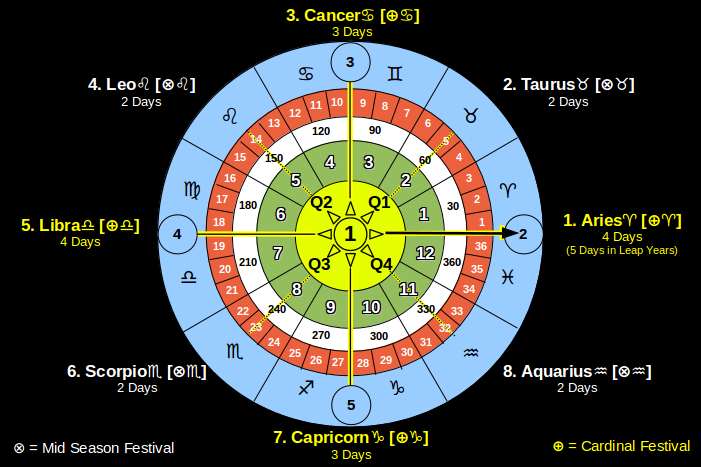
Symbols can again be used as shorthand for these festivals. Cardinal Festivals using the sun cross ⊕ and the relevant Zodiac sign ♈, ♋, ♎ or ♑. Mid Season Festivals using the galactic cross ⊗ and the relevant Zodiac sign ♉, ♌, ♏ or ♒
The eight festivals are summarised below:
| Festival | Q1 | Q2 | Q3 | Q4 |
|---|---|---|---|---|
| Cardinal Festival of: | Aries♈ | Cancer♋ | Libra♎ | Capricorn♑ |
| Symbols: ⊕ | [⊕♈] | [⊕♋] | [⊕♎] | [⊕♑] |
| Ancient Equivalent | Ostara | Litha | Mabon | Yule |
| Mid Season Festival of: | Taurus♉ | Leo♌ | Scorpio♏ | Aquarius♒ |
| Symbols: ⊗ | [⊗♉] | [⊗♌] | [⊗♏] | [⊗♑] |
| Ancient Equivalent | Beltane | Lughnasadh | Samhain | Imbolc |
More About The Great Year[edit]
Since the UCC Year Number is based on where our Solar System is in the Great Year cycle it is pertinent to clarify the nature of this cycle as used by the UCC.
One Great Year equates to one cycle of the precession of the equinoxes i.e. the time it takes for the equinoctial points to complete one whole cycle backwards through all 12 Constellations of the Zodiac. At present various sources claim different lengths for this cycle but typically around 25,920 years. However the UCC uses 24,000 years as the length of the cycle. The reason for the difference is that the actual length of the cycle depends on the rate of precession used to calculate it.
Rate of Precession[edit]
The current (13517 UCC / 2016 C.E.) rate of precession, adopted by the International Astronomical Union (IAU) in 2003, is 50.29 arc seconds per year.[10] As there are 60 arc seconds in an arc minute, 60 arc minutes in one degree and 360 degrees in one cycle there are therefore 1,296,000 arc seconds per cycle (60 x 60 x 360). Assuming the current rate to be constant then gives a projected cycle length of approximately 25,771 years (1,296,000/50.29). However, as the IAU acknowledge in the same journal referenced above, the rate is not fixed but is speeding up over time meaning that the projected cycle length is getting shorter.
The rate of precession has been suggested to speed up and slow down markedly over one complete Great Year cycle such that it is at its quickest at the start of the cycle, reduces to its slowest at the cycle's mid point, then increases again to its quickest at the start of the next cycle[11]. An average rate of 54 arc seconds per year gives a cycle length of 24,000 years (1,296,000/54=24,000) and this has been adopted by the UCC.
It's possible that many astronomical characteristics vary over the course of the Great Year, for example the length of the year itself has been suggested to have been 360 days earlier in history[12][13] and this may be one explanation of why we have 360° in a circle.
The 12 Zodiac Ages of the Great Year[edit]
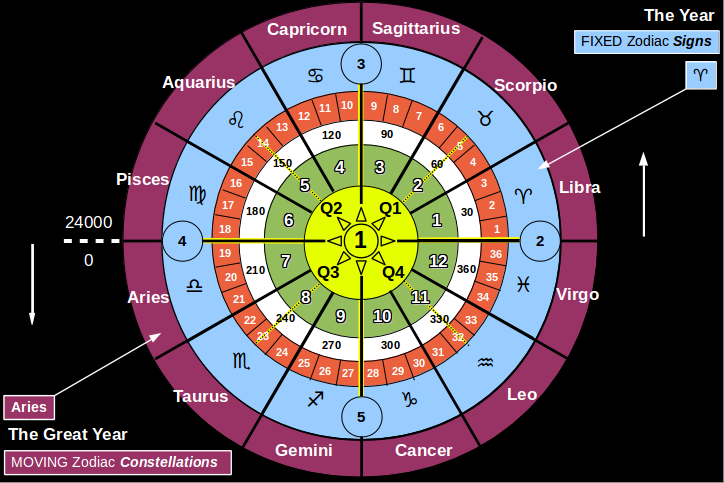
Like the year, the Great Year can be divided into twelve 30° segments. These are known variously as 'Great Months', 'Zodiac Ages', or 'Astrological Ages'. The term Great Month is replaced with 'Great Triad' in the UCC.
Zodiac Signs Versus Zodiac Constellations[edit]
It is very important to the understanding not only of this concept of the 'Ages' but also to astrology and astronomy in general that the distinction is made between ASTROLOGICAL SIGNS and ASTRONOMICAL CONSTELLATIONS:"...the signs of the zodiac should never be confused with the twelve constellations bearing the same names; for though at certain periods of the world's evolution the signs and the constellations coincide, and will do so again, this is not now the case..."[14]
The Astrological Zodiac Signs are 30° segments of the ecliptic inside the solar system[15][16], the Astronomical Zodiac Constellations are 30° divisions of the stars of the Zodiac outside the solar system.[17] The Signs are fixed from an earth perspective to the equinoxes and solstices[18], whilst the Constellations of stars with which they share their names appear to move through the signs, like clouds passing across a window, as the solar system rotates. This is the difference between Tropical Astrology and Sidereal Astrology, the former is based on the fixed signs inside the solar system, whilst the latter is based on the moving constellations of stars outside the solar system.[19]
To visualise this one can imagine two dials (see graphic to the right) both divided into twelve 30° segments, a fixed inner dial (in blue) showing the twelve 30° Astrological Signs of the ecliptic and a moving outer dial (in purple) showing the twelve 30° Astronomical Constellations of stars. Every Great Year the Constellations on the outer dial will complete one anti-clockwise revolution around the Signs on the inner dial. So, from our fixed perspective on Earth, it appears that the Equinoxes marked on the inner dial move clockwise backwards through the segments of the outer dial, hence the term precession. So, this phenomenon that has been termed the Precession of the equinoxes could alternatively be termed the Procession of the zodiac.
The Current Zodiac Age of Pisces[edit]
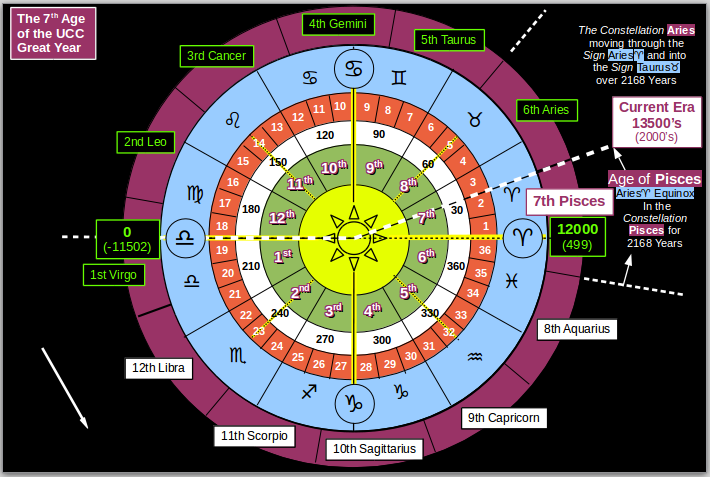
The UCC refers to the current Zodiac Age on some versions of its Year Planners.
In the Great Year the current Zodiac Age at any time is marked by the two opposing Constellations which the Sun is in at the two equinoxes - i.e the position of the outer dial in relation to the inner dial in the above graphic. And, as the Great Year is said to start when the Libra♎ Equinox is at the first point of the Constellation Aries this constellation can also be used as a reference when looking at the night sky to determine where our solar system is in the overall cycle.
Currently the Sun is in the constellations of Pisces at the Aries♈ Equinox and Virgo at the Libra♎ Equinox, and the constellation Aries has passed most of the way through the Sign Aries♈ and on into the Sign Taurus♉. As we divide the year into seasons, the 12 Zodiac Ages (which we can also call 'Great Triads') of the Great Year can likewise be thought of in 'Great Seasons' of the solar system. On this basis we are currently in the 7th Age of the twelve, namely 'Pisces/Virgo'', the first Age of Great Winter. For simplicity the UCC uses just the Aries♈ Equinox as its reference point and so calls this Zodiac Age the Age of Pisces, as shown in bold in the table below:[20]
Table of the 12 Zodiac Ages ('Great Triads')[edit]
|
Great Season |
Age No. |
Age Name |
Aries♈ Equinox in Constellation: |
Libra♎ Equinox in Constellation: |
Constellation Aries passing the Signs: |
|---|---|---|---|---|---|
| Great Summer | 1 | Virgo | Virgo | Pisces | Libra♎ into Scorpio♏ |
| 2 | Leo | Leo | Aquarius | Scorpio♏ into Sagittarius♐ | |
| 3 | Cancer | Cancer | Capricorn | Sagittarius♐ into Capricorn♑ | |
| Great Autumn | 4 | Gemini | Gemini | Sagittarius | Capricorn♑ into Aquarius♒ |
| 5 | Taurus | Taurus | Scorpio | Aquarius♒ into Pisces♓ | |
| 6 | Aries | Aries | Libra | Pisces♓ into Aries♈ | |
| Great Winter | 7 | Pisces | Pisces | Virgo | Aries♈ into Taurus♉ |
| 8 | Aquarius | Aquarius | Leo | Taurus♉ into Gemini♊ | |
| 9 | Capricorn | Capricorn | Cancer | Gemini♊ into Cancer♋ | |
| Great Spring | 10 | Sagittarius | Sagittarius | Gemini | Cancer♋ into Leo♌ |
| 11 | Scorpio | Scorpio | Taurus | Leo♌ into Virgo♍ | |
| 12 | Libra | Libra | Aries | Virgo♍ into Libra♎ |
The First Point of Aries♈[edit]
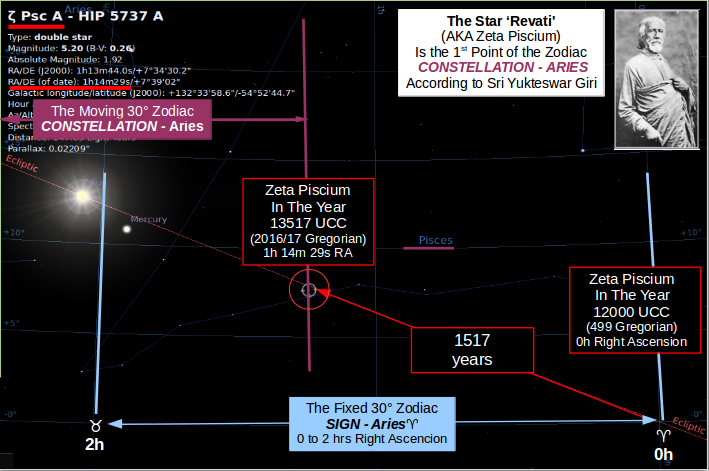
The Signs and the Constellations align when the first point of the Constellation Aries synchronises with the first point of the Sign Aries♈ i.e. with the Aries♈ Equinox. To determine when this occurs we therefore need to define the first point of the Constellation Aries. Sri Yukteswar defined it to be "...the fixed star Revati..."[21] which modern astronomers refer to as Zeta Piscium. The last time this star was close to the Aries♈ Equinox, allowing for the variable rate of precession since then, was in the year 12,000 UCC (499 C.E.)[22] which can be verified using a modern software package such as Stellarium by setting the year to 499 A.D. and noting the location of Zeta Piscium. Hence the Signs and the Constellations of the zodiac align half way through one Great Year of 24,000 years.
Assuming the 24,000 year Great Year, each age lasts 2,000 years on average (24,000/12). However, as mentioned above, the rate of precession varies so it is unlikely that all ages are the same length. The rate in this epoch means that the current Age lasts around 2168 years and as the equinoxes moved into this Age in the year 12,000 UCC (499 Gregorian) they will move into the Age of Aquarius circa the year 14,168 UCC (12,000+2,168) or 2667 Gregorian. Even though this is some 651 years away at the time of writing it means we are in the last 3rd of the current age (651/2168=30%), and this coupled with the fact that the Constellation Aquarius is currently the heliacal rising constellation on the Aries♈ Equinox our present time has been termed the 'dawning of the Age of Aquarius'.
The Four 'Yugas' of the Great Year[edit]
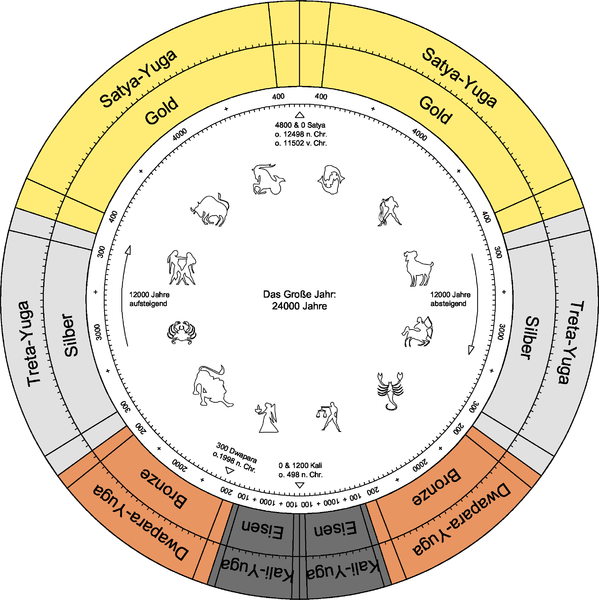
The Great Year in Indian cosmology is said to be divided into 4 'Yugas' of time, each of which represents a decreasing and increasing phase of consciousness, descending for one half cycle and then ascending for the other half cycle, based on the Sun and the rest of its system revolving further from and then closer to a 'grand centre'.[23][24] This principle was also known to the Greeks who termed these Yugas 'Ages' symbolically based on metals of declining values. Accordingly they are named: Satya Yuga (Golden Age); Treta Yuga (Silver Age); Dwapara Yuga (Bronze Age); Kali Yuga (Iron Age). Human consciousness is said to evolve to a peak in the Satya Yuga/Golden Age and then devolve to its base in the Kali Yuga/Iron Age. The lengths of each division in each half cycle is said to be based on tenths in a 4:3:2:1 ratio which produces the following Year table, again showing the current Yuga in bold:
Yugas - Year Numbers Table[edit]
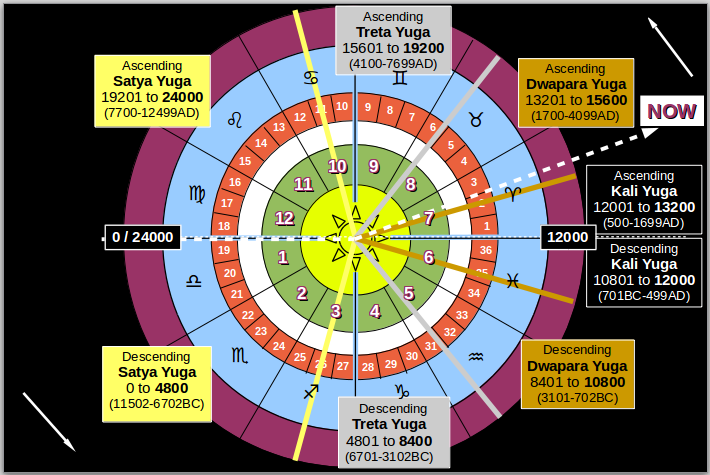
| Hindu Yuga | Greek Age | UCC Year | Greg Year | Length (Yrs) | |
|---|---|---|---|---|---|
| Descending Arc | Satya | Golden | 0 | -11502 | 4,800 |
| Treta | Silver | 4800 | -6702 | 3,600 | |
| Dwapara | Bronze | 8400 | -3102 | 2,400 | |
| Kali | Iron | 10800 | -702 | 1,200 | |
| Ascending Arc | Kali | Iron | 12000 | 499 | 1,200 |
| Dwapara | Bronze | 13200 | 1699 | 2,400 | |
| Treta | Silver | 15600 | 4099 | 3,600 | |
| Satya | Golden | 19200 | 7699 | 4,800 | |
| Next Descending Arc | 24000 | 12499 |
Current Yuga - Dwapara Ascending[edit]
The UCC refers to the Yuga Cycle on its Year Planners by stating the year number of the current Yuga Phase/Greek Age. Presently we are in the Dwapara Ascending Yuga/Ascending Bronze Age. As the current Yuga lasts for a total of 2,400 years and began in 13201 UCC (1700 C.E.) this makes the current year of 13517 (2016/17 C.E.) its 317th year (13517-13200) and means it will last a further 2,083 years, until we begin the Treta Ascending Yuga in 15601 UCC (4100 C.E.).
Dwapara Ascending is said to be the age of electricity when man once again discovers that "...all matter is an expression of energy, vibratory force and electrical attributes..."[25] and the age when mankind has empowered self interest, awakened and reasoning intellect and perception of the subtle energies underlying gross matter & within himself.[26]
The Descending & Ascending Zodiac Ages[edit]
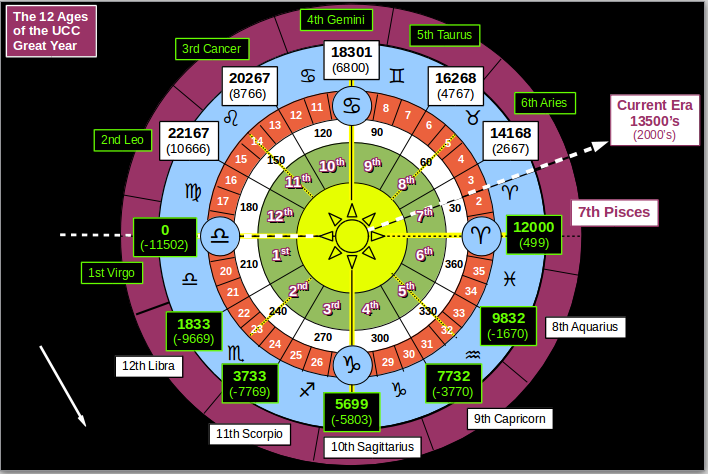
The Yuga cycle overlays with the Zodiac Ages such that each half cycle encompasses 6 of the 12 Zodiac Ages, commencing with Virgo.
Assuming an elliptical rotational orbit for the solar system (similar to that of the Earth's around the Sun) the rate of precession gradually reduces over the Descending Arc, from its peak at the start of the Great Year to its slowest rate and then gradually increases again over the Ascending Arc back to its fastest rate, as our system moves away from and then closer to the 'grand centre'[28]
This gives varying average rates for, and therefore variable lengths to, each 30° Zodiac Age and so varying projected lengths to the total Great Year which might be assumed from the perspective of people living during those Ages.
These are summarised in the following table with the year numbers that each Age starts and their lengths in years. The table shows the estimated Average Rates of Precession over each Age in arc seconds per year and what the total projected length of the Great Year (in years) would be if that rate were constant. Again, the current Age is shown in bold:
Zodiac Ages - Year Number Table[edit]
|
Half Cycle |
Great Season |
Age No. |
Age Name |
UCC Year |
Greg Year |
Length (Years) |
Average Rate (arc secs/yr) |
Great Year Length |
|---|---|---|---|---|---|---|---|---|
| Descending Arc | Great Summer | 1 | Virgo | 0 | -11502 | 1,833 | 58.92 | 21,996 |
| 2 | Leo | 1833 | -9669 | 1,900 | 56.84 | 22,800 | ||
| 3 | Cancer | 3733 | -7769 | 1,966 | 54.93 | 23,592 | ||
| Great Autumn | 4 | Gemini | 5699 | -5803 | 2,033 | 53.12 | 24,396 | |
| 5 | Taurus | 7732 | -3770 | 2,100 | 51.43 | 25,200 | ||
| 6 | Aries | 9832 | -1670 | 2,168 | 49.82 | 26,016 | ||
|
Ascending Arc
|
Great Winter
|
7
|
Pisces
|
12000
|
499
|
2,168
|
49.82 (Now 50.29) |
26,016 (Now 25,771) |
| 8 | Aquarius | 14168 | 2667 | 2,100 | 51.43 | 25,200 | ||
| 9 | Capricorn | 16268 | 4767 | 2,033 | 53.12 | 24,396 | ||
| Great Spring | 10 | Sagittarius | 18301 | 6800 | 1,966 | 54.93 | 23,592 | |
| 11 | Scorpio | 20267 | 8766 | 1,900 | 56.84 | 22,800 | ||
| 12 | Libra | 22167 | 10666 | 1,833 | 58.92 | 21,996 | ||
| Total/Average | 24000 | 12499 | 24,000 | 54.00 | 24,000 |
There is a precedent for this principle of increase and decrease in the Year cycle, whereby the slight eccentricity of Earth's elliptical orbit (0.0167) means that the Earth moves through two arcs to points furthest away from and then closest to (aphelion & perihelion) the Sun. This makes the two arcs, the two halves of the year and each Zodiac Sign of slightly different lengths, as is suggested by way of correspondence, in the Great Year model adopted by the UCC.
Proposed Aims & Benefits[edit]
The UCC is intended to:
- be universal - as it's elements and terms are the same wherever one is on the planet;
- be celestial - as it is based on the natural relationship of Earth to celestial objects, the Sun and the Zodiac (celestial means 'of the sky');
- be easy to use - by having equal lengths to all subdivisions of the year, a balanced geometric structure and the decimal 10 day Decan;
- release us from the restrictive peaks & troughs (and their associated costs) of the seven day week - by having no distinction between weekdays and weekends;
- reunite us with natural cycles - by following the equinoxes & solstices, their associated seasons and the celebrations of the eight fold year;
- reunite aspects of astronomy with astrology - by following the journey of our main celestial body, the Sun, through the zodiac Signs each Year & Constellations each Great Year
- remind us of where we are in the cycle of the ages - by following the year numbers and zodiac ages of the Great Year;
- realise better work/life balance - by freeing more time for individual self realisation via the 10 day Decan
All of which are intended to support community development in harmony with nature.
UCC Resources[edit]
The UCC has the following resources available:
UCC Calendar Clock APP - Fully animatable Web Development Application (coded by Prajna Pranab) for Android & Desktop Browsers
Date Calculator - UCC to Gregorian and vice versa.
Calendar Converter/Year Planner - showing the UCC year with equivalent Gregorian dates.
Full Year Calendar - in landscape format with a page for each Intercalary Day and a page for each Triad, also show Gregorian dates for each day.
Coding with UCC Dates[edit]
Prajna Pranab has developed a JavaScript library and MediaWiki Widget that simplify using UCC Dates on web pages and wiki pages.
How To Generate The Symbols Used By The UCC[edit]
The symbols are produced by using 'Unicode' characters which can be generated in various ways depending on the operating system one uses. For example in Linux one would hold down <shift> and <ctrl> together then type the letter 'u' followed by a four digit 'UTF-16' Unicode for the character concerned entered via the numeric key pad.
Intercalary Days & Triads[edit]
The required codes for the main elements of the UCC in chronological order through the year are:
| Element | Name | Day #'s of 365 | Character | Code |
|---|---|---|---|---|
| Intercalary Day 0 | Leap Year's Day | 000 | ✶ | 2736 |
| Intercalary Day 1 | New Year's Day | 001 | ❂ | 2742 |
| Intercalary Day 2 | 1st Season's Day | 002 | ◷ | 25F7 |
| Triad 1 | ONE-Aries♈ | 003-032 | ♈ | 2648 |
| Triad 2 | TWO-Taurus♉ | 033-062 | ♉ | 2649 |
| Triad 3 | THREE-Gemini♊ | 063-092 | ♊ | 264A |
| Intercalary Day 3 | 2nd Season's Day | 093 | ◴ | 25F4 |
| Triad 4 | FOUR-Cancer♋ | 094-123 | ♋ | 264B |
| Triad 5 | FIVE-Leo♌ | 124-153 | ♌ | 264C |
| Triad 6 | SIX-Virgo♍ | 154-183 | ♍ | 264D |
| Intercalary Day 4 | 3rd Season's Day | 184 | ◵ | 25F5 |
| Triad 7 | SEVEN-Libra♎ | 185-214 | ♎ | 264E |
| Triad 8 | EIGHT-Scorpio♏ | 215-244 | ♏ | 264F |
| Triad 9 | NINE-Sagittarius♐ | 245-274 | ♐ | 2650 |
| Intercalary Day 5 | 4th Season's Day | 275 | ◶ | 25F6 |
| Triad 10 | TEN-Capricorn♑ | 276-305 | ♑ | 2651 |
| Triad 11 | ELEVEN-Aquarius♒ | 306-335 | ♒ | 2652 |
| Triad 12 | TWELVE-Pisces♓ | 336-365 | ♓ | 2653 |
Days of the Decan[edit]
Those wishing to also use symbols for the days of the Decan can refer to the table below:
| Day | Orb | Character | Code |
|---|---|---|---|
| 1 | Sun | ☉ | 2609 |
| 2 | Mercury | ☿ | 263F |
| 3 | Venus | ♀ | 2640 |
| 4 | Earth | ⊕ or ⴲ | 2295 or 2D32 |
| 5 | Mars (Maris) | ♂ (♁) | 2642 (2641) |
| 6 | Ceres | ⚳ | 26B3 |
| 7 | Jupiter | ♃ | 2643 |
| 8 | Saturn | ♄ | 2644 |
| 9 | Uranus | ♅ | 2645 |
| 10 | Neptune | ♆ | 2646 |
Mid Season Festivals[edit]
The additional character required for these is '⊗' and its Unicode is 2297.
See Also[edit]
Further Reading[edit]
The Holy Science. Yukteswar, Sri. Self Realisation Fellowship (1990). ISBN:9780876120514 Read it at Google Books
Lost Star of Myth and Time. Cruttenden, Walter. St Lynn's Press (2005). ISBN:9780976763117
The Yugas. Selbie, Joseph & Steinmetz, David. Crystal Clarity (2010). ISBN:9781565892538
Precession or The Battle of the One True Zodiacs. Bulgerin, Martin. BioPsciences Institute (2004). Link
Worlds In Collision. Velikovsky, Immanuel. Doubleday (1977). ISBN:978067181091X
Marking Time. Steel, Duncan. Wiley (1999) ISBN:9780471298271
External Links[edit]
Universal Celestial Calendar (introductory overview)
Universal Celestial Calendar (main home page)
Standing Proposals for Calendar Reform
Notes & References[edit]
- Jump up ↑ The Holy Science (Introduction). Yukteswar, Sri. Self Realisation Fellowship Publishers (1990). ISBN: 9780876120514
- Jump up ↑ EAST - WEST Article at www.mysticalportal.net Link
- Jump up ↑ 'A Year Zero?'. NB. There is no year zero between -1BCE and 1CE in the Gregorian calendar which one must take into account when corresponding Gregorian year numbers to those of the Great Year. The UCC has a year zero corresponding to 11502BCE.
- Jump up ↑ The Friends of the Diggers Alternative Community
- Jump up ↑ Troubadour Community Trust
- Jump up ↑ On trial within the Universal Community Trust (date of treaty references UCC)
- Jump up ↑ Why 'Triads' instead of 'Months'?: The term 'month' is not considered appropriate since it derives from 'moon-th' and the moons 28/29 day cycle, which has since been used generically to express a subdivision of a year.
- Jump up ↑ 'Zodiac Ages': In this current Zodiac Age of Pisces the Zodiac Constellations are occupying most of the next Zodiac Sign in the sequence due to the precession of the equinoxes. So the Constellation Pisces is mostly in the Sign Aries♈, the Constellation Aries is mostly in the Sign Taurus♉ and so on. (see 'The 12 Zodiac Ages of the Great Year' section).
- Jump up ↑ Names of Equinoxes & Solstices: These have typically been Northern Hemisphere biased with terms like 'Spring' or 'Vernal' (which also means Spring!) Equinox and 'Autumn' Equinox, 'Summer' Solstice etc., but using seasonally based terms doesn't work for those in the Southern Hemisphere where the seasons are reversed. The UCC uses 'Universal' terms which work regardless of hemisphere as follows: Aries♈ Equinox or 'Nobenox' (a contraction of 'North Bound Equinox'); Cancer♋ Solstice or 'Nolstice' (a contraction of 'Northern Solar Stasis'); Libra♎ Equinox or 'Sobenox' (a contraction of 'South Bound Equinox'); Capricorn♑ Solstice or 'Solstice' (a contraction of 'Southern Solar Stasis')
- Jump up ↑ Expressions for IAU 2000 precession quantities. Capitaine, N. Astronomy & Astrophysics Journal: Section 4.3. (2003-09-19). DOI:10.1051/0004-6361:20031539 Link
- Jump up ↑ Lost Star of Myth and Time. Cruttenden, Walter. St Lynn's Press (2005). ISBN:0976763117. Pages 121-127
- Jump up ↑ Worlds In Collision. Velikovsky, Immanuel. Doubleday (1977). ISBN:067181091X. Page 327 (Chapter 8)
- Jump up ↑ An 'Ideal' Earth Year of 360 Days?. Hunter, Keith. Ancient World Mysteries (2015)
- Jump up ↑ Astrology For All. Leo, Alan. Cosimo Classics (2006). ISBN:9781596059245. Page 7 (para 4)
- Jump up ↑ Ibid: Page 8 (last para N.B.)
- Jump up ↑ The Light of Egypt: Volume Two. Burgoyne, Thomas H. The Book Tree (1999). ISBN:9781585090525. Page 8 (para 3)
- Jump up ↑ Zodiac Constellation Boundaries: The issue has been further confused since the International Astronomical Union defined the boundaries of modern constellations, including those in the zodiac, with different sizes based on the arrangements of the stars within them. However the original zodiac was based on constellations (viz. areas of the sky) of 30° each and these are still used in Sidereal Astrology:
"...it must be acknowledged that the Jyotir Veda describes both the nirayana cakra (sidereal zodiac) and the sayana cakra (tropical zodiac), and that each of these zodiacs is composed of twelve rasis..."
Dasa, Antardwipa: 'A Tale of Two Zodiacs' (2012). Para.12. - Jump up ↑ Astrology For All Ibid (above)
- Jump up ↑ 'Writing The Names of Signs & Constellations': To avoid confusion between Signs and Constellations the UCC refers to the Signs (and therefore the names of its Triads) using the zodiac symbols, either alone or attached to the names of the Signs , but refers to the Constellations with just their names, viz: the sign '♈' or 'Aries♈'; the constellation 'Aries'.
- Jump up ↑ Zodiac Ages & The Equinoxes: Those who use only the Aries♈ Equinox as their reference call this the Age of Pisces whilst those who use only the Libra♎ Equinox as their reference call it the Age of Virgo.
- Jump up ↑ The Holy Science Ibid (above)
- Jump up ↑ The Holy Science Ibid (above)
- Jump up ↑ The Holy Science Ibid (above).
- Jump up ↑ The Yugas. Selbie, Joseph & Steinmetz, David. Crystal Clarity (2010). ISBN:9781565892538. Page 52
- Jump up ↑ Lost Star of Myth and Time Ibid above. Page 73
- Jump up ↑ The Yugas Ibid (above). Page 52
- Jump up ↑ The Current Year & Age: At the time of writing the solar system has rotated through about 203° over the last 13,517 years since the start of the Great Year, such that the Constellation Aries, that started in the Sign Libra♎ has moved through the Signs of Libra♎, Scorpio♏, Sagittarius♐, Capricorn♑, Aquarius♒, Pisces♓, about 2/3rds of Aries♈ and on into Taurus♉. This means that the Aries♈ Equinox, our reference point, which started in the Constellation of Virgo has since precessed through the Constellations of Virgo, Leo, Cancer, Gemini, Taurus and Aries and about 2/3rds of the way through the Constellation of Pisces where it currently resides, hence the current Zodiac Age/Great Triad being that of Pisces. Since the Age of Pisces began in the year 12000 UCC (499 C.E. Gregorian) the current year - 13517 - is the 1,517th year of the Piscian Age
- Jump up ↑ Lost Star Ibid (above).
